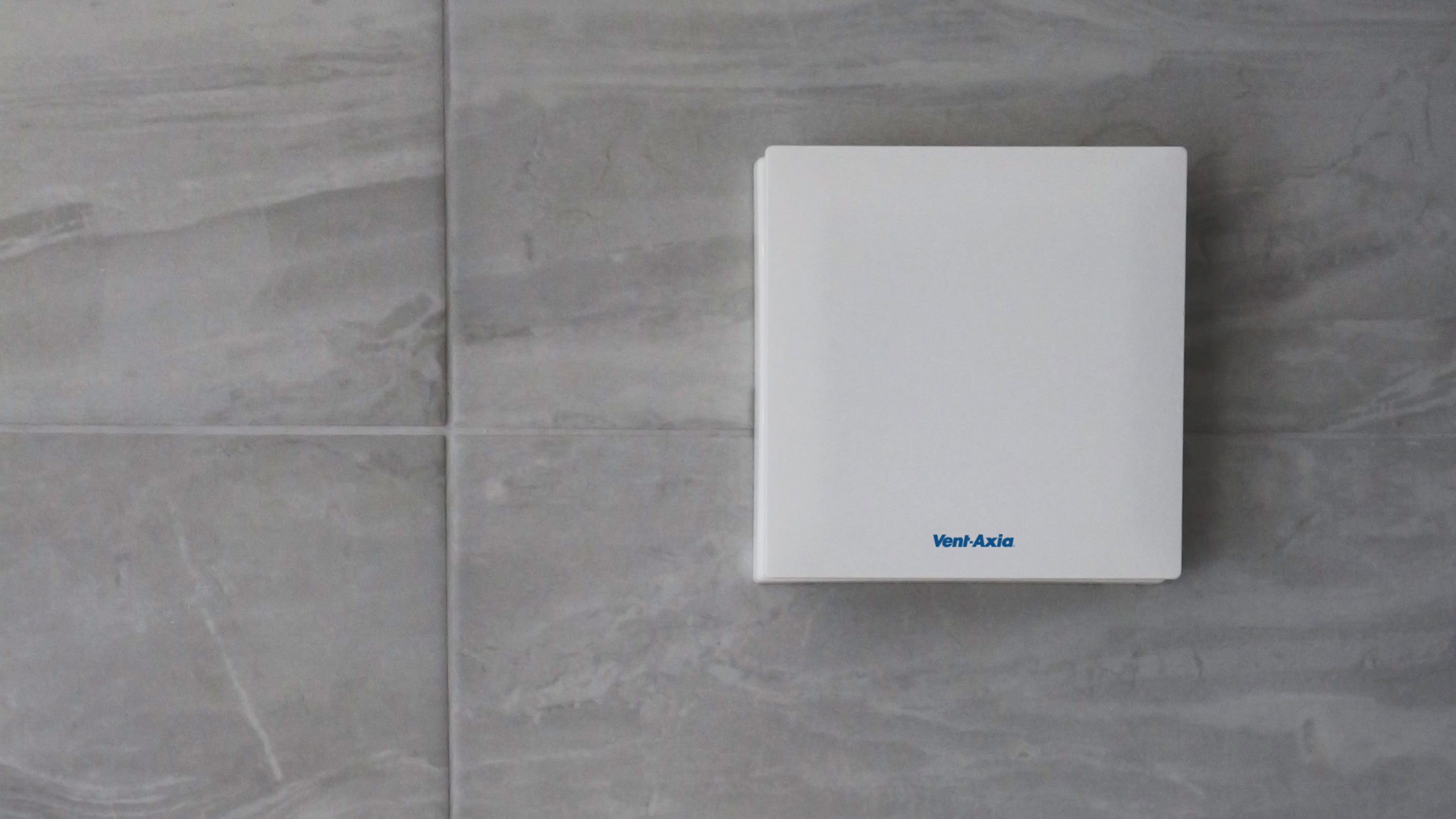Why prioritising bathroom ventilation will effectively eliminate moisture and high humidity once and for all
Introducing good bathroom ventilation makes perfect sense. Find out how to ensure that steam, moisture and condensation don’t provide a breeding ground for unwanted mould

A bathroom is one room in the home that experiences high moisture and condensation, especially when running a hot bath or shower. Without bathroom ventilation, moisture will remain in the air and seep into surfaces. As soon as this happens, mould will start to grow where you don’t want it.
Natural ventilation is part of a good ventilation mix in a bathroom, but it's not always a viable option. Here, we look at why bathroom ventilation is important, the best ways to address it, and the different types of extractor fans that can help provide the right level of ventilation.

Chris and his partner Michelle started Meaco in 1991. Meaco is now regarded internationally as a major player in the dehumidifier industry selling to 20+ countries. Meaco sets the benchmark for quality and development in its sector, leading by example and reducing the energy consumption of its appliances.
The importance of bathroom ventilation
Bathrooms are hardworking spaces, and daily, they experience significant fluctuations in moisture and humidity due to the activities that take place there. Rather than spending your time dealing with mould in bathrooms, it is better to prevent it from forming in the first place.
"The bathroom is one of the major sources of moisture in the home and tends to be used for bathing and showering daily," says Chris Michael, Managing Director of Meaco. "Without good extraction, the levels of moisture will build and build, which can result in mould growth within the room.
According to Victoria Plum: "Water vapour equating to as much as 10 litres can be released inside your home daily, which, unless extracted, can reduce air quality and lead to the formation of mould and damp."
While other rooms in the house will also contribute to this water vapour, the large amounts of water produced by bathing, washing, and showering every day in the bathroom make it particularly essential to address the moisture in this space.
Try these to help improve bathroom ventilation

This dehumidifier removes up to 16 L of moisture per day, creating a dry, comfortable living environment. Use outside a bathroom door.

An axial bathroom fan with a short pipe for fixing to a wall, ceiling or window. Offers protection against splashing water and features an automatic closure seal to minimise vibrations.

A compact 100mm extractor fan ideal for wall and ceiling fitting in bathrooms, shower rooms and toilets. It is operated by a simple on and off switch, typically connected to a light switch.
Best way to ventilate a bathroom
Installing mechanical ventilation is the best way to ensure your bathroom remains well ventilated. For most people, this will mean installing an extractor fan.
Bring your dream home to life with expert advice, how to guides and design inspiration. Sign up for our newsletter and get two free tickets to a Homebuilding & Renovating Show near you.
That said, if you have mechanical ventilation with heat recovery (MVHR) installed in your home, fitting an extractor fan will be unnecessary – in fact, it could actually interfere with the MVHR's performance.
"The bathroom is one of the main sources of heat that the MVHR system is trying to recover, so an extractor fan would actually be detrimental to the system," explains Tim Pullen, an expert in sustainable building methods and energy efficiency in residential homes and author of The Sustainable Building Bible, amongst other titles.
"It would suck all that lovely warm air resulting from your shower and exhaust it to the atmosphere, rather than recirculating it to warm the air being delivered to the bedrooms, lounge, etc."

Tim is an expert in sustainable building methods and energy efficiency in residential homes and wrote on the subject for magazines and national newspapers. He is the author of The Sustainable Building Bible and Simply Sustainable Homes.
If you are going to be relying on an extractor fan, be sure that it is positioned correctly in order to make the most of it. Fans should be positioned as high as possible on the wall, close to the main source of steam and well away from any sources of 'replacement air' such as windows.
"A bathroom fan shouldn’t be installed just anywhere. Fans that are suitable for wall, ceiling or window installation make choosing where to locate the fan much easier," says Natasha King, RMI Product Manager at Vent-Axia. "In larger bathrooms a fan can be installed safely away from any sources of water spray. But in smaller rooms, such as an en suite, this may not be possible. In these cases, a fan with an IP45 rating (for Zone 1) can be safely installed in the splash zone.
"Another feature to look out for is variable speed models, where fan speed can be adjusted to meet the individual airflow needs of the project – this is especially helpful with long duct runs. Plus, variable speed models can be altered to achieve the required airflow at a sound level that is acceptable to an individual household."

King is the RMI Product Manager at Vent-Axia who are forerunners in energy-saving, lo-carbon products. They are committed to helping improve indoor air quality and comfort in both homes and buildings.

Types of extractor fans for bathrooms
In order to get the ventilation spot on in your room it is important to choose the best bathroom extractor fans for your needs. There are three main types of extractor fan, each suitable for different situations:
- Centrifugal fan: This type of extractor fan is perfect if your bathroom is located more than 1.5 metres from an external wall. Centrifugal fans – which are commonly fitted into ceilings – are more powerful than other types of extractor meaning they can move air further. On the downside, they are often a little noisier than other models due to their powerful motors.
- Axial: If your bathroom is 1.5m or less from an external wall, an axial extractor fan may do the job of removing stale air just fine. They are less powerful than centrifugal fans and are therefore usually quieter too.
- Inline: In some cases neither of the above types of extractor fan will be sufficient to ventilate your bathroom – this is where inline fans come in. These fans are designed to be capable of moving stale air much longer distances than either of the above – often at least 40m.
There are also a whole host of newly developed features to look out for when selecting a bathroom extraction fan, many of which will improve the indoor air quality (IAQ) in the space further.
"Intelligent, fully automatic humidistats are also a great addition in the fight against moisture," says Natasha King. "Fans with this feature, such as Vent-Axia’s PureAir Sense, learn to run only when they can make a difference to IAQ. It can also sense when someone is in the room and then activate the fan. These intuitive sensors can reliably recognise room occupancy through light movement and shadows, but can distinguish between car headlights flashing and people moving about to avoid nuisance running."
She adds, "Additionally, the delay-on feature avoids the fan being triggered in the night during quick bathroom visits. Finally, an airing function is ideal for those who are away a lot or for a guest bathroom. This runs the fan for an hour if it has been inactive for over a day, ridding the room of stale air and stuffy, musty odours."

Choosing the right size
Along with choosing an extractor fan that will suit the location of your bathroom in your home, it is really important to select the right sized model – too small for the space and the money you spend on it could well be wasted, too big and you will be using more energy than you need.
"First up is making sure the fan you choose is up to the job. This means it meets the air change requirements for the room, to ensure that steam and smells are removed at source," says Natasha King. "This not only prevents condensation and mould appearing in the bathroom, it also stops moisture migrating to colder parts of the house and causing damage around the home."
You need to base your choice of fan on its extraction rate – the amount of air that can be removed from a room in an hour. The extraction rate will usually be measured in m3 per hour – m3/hr.
Next you need to turn your attention to 'air change'.
"For bathrooms it’s recommended that you should have four air changes per hour (you may wish to increase air changes depending on the size of the bathroom) with an extract rate of no less than 54m3/h at 15 l/sec. Alternatively, you could ventilate continuously at 0.3l/s/m2," says Natasha. One l/s is approx. 3.6 m3/hr.
In order to work out the extraction rate you need, calculate the size of your room in cubic metres by multiplying the height, width and length of the room – so, for example, if your bathroom measures 3m high x 3m wide x 2m long, you would carry out the following calculation:
3m x 3m x 2m = 18m3.
This means that in order to change the air in that room once an hour, a fan would need an extraction rate of 18m3/h. For the room to have the required four air changes per hour, you would need a fan with an extract rate of 72m3/h (4 x 18m3/h).
FAQs
What are ventilation building regulations for bathrooms?
The type of ventilation required by the building regulations will depend on your bathroom but, unless you have a bathroom with no windows, there is no legal requirement for you to fit an extractor fan. That said, relying on a window alone to ventilate your bathroom is going to leave you very chilly in the winter months.
In new bathrooms, with a bath and shower, mechanical ventilation is required – and this means an extractor fan or MVHR. In a bathroom, you will need to fit a fan with a minimum extraction rate of 15 l/s.
If, on the other hand, you are renovating a bathroom that currently has only a window for ventilation, there is no requirement to install an extractor fan – but it is highly recommended that you do, particularly if you are looking at how to stop condensation, mould and damp from becoming problematic.
Is my extractor fan working properly?
If you are renovating a bathroom with an existing extractor fan there is an easy way to check that it is working.
"A good extractor fan is essential in keeping a bathroom dry and there is a simple test that you can do to judge whether your extractor fan is up to the job," says Chris Michael. "Take a sheet of A4 paper and hold it up to the extractor fan, if it sticks, then the suction from the fan is good and the extractor is doing its job, if the paper falls to the ground, then the extractor needs cleaning or replacing."
Can you use a dehumidifier in the bathroom?
Dehumidifiers are a great way to reduce the humidity in a room and to keep it free of condensation, damp and mould – however, they cannot be used in bathrooms.
"A good option would be to place a dehumidifier on the landing or hallway outside your bathroom or shower room," advises Meaco's Chris Michael. "If you leave the bathroom door open once you have finished, then the damp air in the room will naturally move towards the dehumidifier (damp air migrates to a dry spot) and the dehumidifier will keep the bathroom and the landing and bedrooms dry without the need to have the dehumidifier in the actual bathroom.
"An added bonus is that the towels in the bathroom will dry faster as well. This solution is helpful where you don’t have an extractor fan and you don’t want to or can’t leave a window open."
Dehumidifier running costs might not be as high as you think and you can also use them to dry clothes quickly.

If you’re renovating a bathroom, you need to consider more than just ventilation. Check out our guides on Where to buy bathroom tiles, bathroom layout mistakes to avoid and some smart modern bathroom ideas.
Natasha was Homebuilding & Renovating’s Associate Content Editor and was a member of the Homebuilding team for over two decades. In her role on Homebuilding & Renovating she imparted her knowledge on a wide range of renovation topics, from window condensation to renovating bathrooms, to removing walls and adding an extension. She continues to write for Homebuilding on these topics, and more. An experienced journalist and renovation expert, she also writes for a number of other homes titles, including Homes & Gardens and Ideal Homes. Over the years Natasha has renovated and carried out a side extension to a Victorian terrace. She is currently living in the rural Edwardian cottage she renovated and extended on a largely DIY basis, living on site for the duration of the project.

